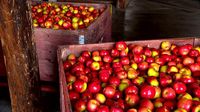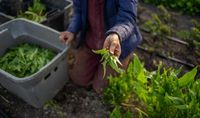TULARE COUNTY, Calif. — Cuts to food programs by the U.S. Department of Agriculture (USDA) and the Trump administration are threatening essential services provided to millions of Americans. As food insecurity rises, local organizations like Foodlink of Tulare County are feeling the crunch of an intended $1 billion reduction in federal food assistance.
Executive Director Andrea Kelly stated the cuts will impact Foodlink directly by roughly $100,000, a significant loss. “That’s 12 full truckloads, semi-truckloads full of food, right? You know, almost a million pounds of food will not go out to Tulare County residents if those orders are not brought back up,” she explained, highlighting the severity of the situation.
The USDA defended its actions, suggesting there is no longer a need for the pandemic-era assistance, citing a focus on its core mission of strengthening food security. The USDA stated, “We are prioritizing stable, proven solutions that deliver lasting impact.” This shift, however, poses risks to food banks grappling with growing demand amidst reduced supply.
Farmers are also feeling the impact of the cuts. Bryce Loewen, a fourth-generation farmer at Blossom Bluff Orchards, commented, “The idea of having these programs in trimming the fat, there is not much fat to be trimmed. It's already lean.” As farmers lose contracts previously established with food banks, the repercussions are felt throughout the agricultural community.
Food banks beyond Tulare County, including the Central California Food Bank that serves over 300,000 individuals, face similar challenges. A significant portion of those served are children, indicating the cuts may have dire consequences for vulnerable populations.
Meanwhile, in northeastern North Carolina, the Food Bank of the Albemarle is bracing for a $1 million loss, equivalent to 500,000 pounds of food due to the federal cuts. Brian Gray, the Food Bank's Communications & Volunteer Manager, expressed frustration, noting that over 43,000 residents rely on their services, which translates to 1 in 7 people seeking food assistance. “We’re trying to figure out how we’re going to replace that food right now,” he stated.
The cuts to the Federal Nutrition Program could eliminate approximately 3,325,000 pounds of food or 2,770,833 meals, representing 38 percent of the food bank’s annual distribution. Gray warned that food banks and pantries cannot make up the difference created by these funding cuts.
Additionally, in Asheville, North Carolina, the USDA announced the end of the Local Farm Produce Assistance program, which had facilitated millions in funding for foodbanks to source local fruits and vegetables. MANNA FoodBank CEO Claire Neal expressed devastation over losing over $11 million expected for North Carolina in 2025, citing that these resources provide necessary nourishment to families facing food insecurity.
Moving to Texas, the cuts to the Local Food Purchase Assistance Cooperative Agreement program (LFPA) will hinder local food banks' ability to provide either meat or produce sourced from state farmers. South Plains Food Bank CEO Dina Jeffries reported receiving about $1.2 million from the USDA under LFPA, which allowed them to provide 3.6 million meals. “Now we have to come up with it and so we will have to purchase food out of our own resources and it’s just very costly,” she lamented.
In West Virginia, Trey Yates, a dairy farmer, is concerned that the cuts threaten his Greenbrier Dairy, which depends almost entirely on selling to schools and food banks. “This is morally wrong on many levels,” Yates remarked. With substantial funding cuts impacting the local agricultural economy and food banks, communities are left scrambling for solutions.
The USDA has noted that it will honor existing contracts until September 2025, but there’s significant concern about what the future holds without renewed funding. Local and state officials speculate about the outcome of future cuts, as they strategize how to maintain food quality and access for families in need.
Michigan is no stranger to this dilemma either. Green Wagon Farm intends to produce 500 pounds of greens weekly for food banks, but the impending loss of a federal grant program means significant operational adjustments are required. Owner Heather Anderson voiced her disappointment, illustrating the widespread effects of this funding cut that is meant to support local food systems.
The broader theme appears stark: cuts to programs designed to assist the most vulnerable—those relying on food banks for aid—are causing local agricultural economies to also falter. The repercussions are felt from state to state, raising alarm as food insecurity rates escalate. In the wake of rising inflation, America's food-insecure households have risen from 17 million to 18 million in just one year.
As stakeholders in communities across the country make plea after plea for support and the need for donations, advocates push for wider community awareness regarding their plight. Local organizations implore residents to reach out to state representatives, increasing pressure to advocate for the reinstatement of critical food assistance programs.
As communities grapple with these changes and search for solutions, it’s evident the cuts to the USDA programs represent a more pressing issue: ensuring that access to nutrition remains a priority in an ever-changing landscape.
Though the USDA cites a return to more stable and proven solutions, many are left questioning the long-term implications of these decisions and the sustainability of food security moving forward. The future of food banks, local farmers, and families reliant on assistance hangs in the balance.









